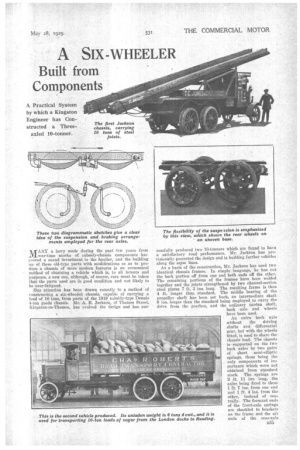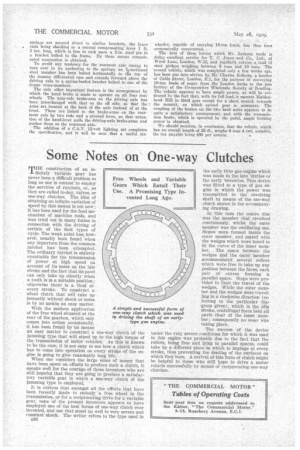• A SIX-WHEELER Built from Components
Page 61

Page 62

If you've noticed an error in this article please click here to report it so we can fix it.
MANY a lorry made during the past few years from war-time stocks of subsidy-chassis components has proved a sound investment to the haulier, and the building up of these old-type parts with modifications so as to produce a chassis of more modern features is an economical method of obtaining a vehicle which is, to all intents and purposes, a new one, although, of course, care must be taken that the parts used are rn good condition and not likely to be over-fatigued.
Our attention has been drawn recently to a method of constructing a six-wheeled chassis, capable of carrying a load of 10 tons, from parts of the 1919 subsidy-type Dennis 4-ton goods chassis. Mr. A. E. Jackson, of Thames Street, Kingston-on-Thames, has evolved the design and has sue cessf ally produced two 10-tonners which are found to have a satisfactory road performance. Mr. Jackhon has provisionally protected the design and is building further vehicles along the same lines. As a basis of the construction, Mr. Jackson has used two identical chassis frames. In simple language, he has cut the back portion off from one and both ends off the other. The remaining portions of the frames have been welded together and the joints strengthened by two channel-section steel plates 7 ft. 3 ins. long. The resulting frame is thus 4 ft. longer than standard. The middle bearing of the propeller shaft has been set back, an intermediate shaft 9 ins. longer than the standard being employed to carry the drive from the gearbox, and the ordinary cardan shaft, back axle and wheels have been used.
An extra back axle without the driving shafts and differential gear, but with the wheels fitted, is used to share the chassis load. The chassis is supported on the two back axles by two pairs of short semi-elliptic springs, these being the only components of importance which were not obtained from standard stock. The springs are 2 ft 11 ins. long, the axles being fixed to them 1 ft. 7 ins, from one end and 1 ft. 4 ins, from the other, instead of centrally. The forward ends of the front-axle springs are shackled to brackets on the frame and the aft ends of the rear-axle springs are secured direct to similar brackets, the inner ends being shackled to a central compensating lever 1 ft. 3 ins, long, which is free to rock upon a 2-in, steel pin in a bracket bolted to the frame. By these means compensated sesnension is obtained.
To avoid any tendency for the rearmost axle casing to turn over in its anchoring to the springs, an L-sectioned steel member has been bolted horizontally to tfie top of tla.; dummy differential case and extends forward above the driving axle to a spring-loaded bracket bolted to one of the frame cross-members.
The only other important feature is the arrangement by which the hand brake is made to operate on all four rear wheels. The near-side brake-arm on the driving axle has been' interchanged with that on the off side, .so that the arms are located at the back of the axle instead of at the front. These are linked to the brake-arms on the rearmost axle by two rods and a pivoted lever, so that actuation of the hand-lever pulls the driving-axle brake-arms and pushes those on the rearmost axle.
The addition of a C.A.V. 12-volt lighting set completes the specification, and it will be seen that a useful six wheeler, capable of carrying 10-ton loads, has thus been economically constructed.
The first of these lorries which Mr. Jackson made is doing excellent service for T. C. Jones and Co., Ltd., of Wood Lane, London, w.rz, and regularly carries a, load 'Of steel girders weighing between 9 tons and 10 tons. The • second vehicle, which was completed only a few weeks ago, has been put into service by Mr;Charles Roberts, a-haulier of Cable .ktreet, London, E.1, for the purpose of conveying 10-ton loads of sugar frpm the London .docks to the jam factory of the Co-operative Wholesale Society at Readiug. The vehicle appears to have ample power, as will be evidenced by the filet that, with itS tEl-Moe& it mounts Maidenhead Hill in third gear except for a short stretch towards the summit, on which second gear is necessary. The coupling of the brakes on the two back axles appears to be quite a satisfactory arrangement, and with the transmission brake, which is operated by the pedal, ample braking
• power is obtained. We should mention, in conclusion, that the vehicle, which has air overall length of 25 ft., weighs 6 tons 4 cwt. 'unladen, • the tax payable being £60 per annum. •




















































































































